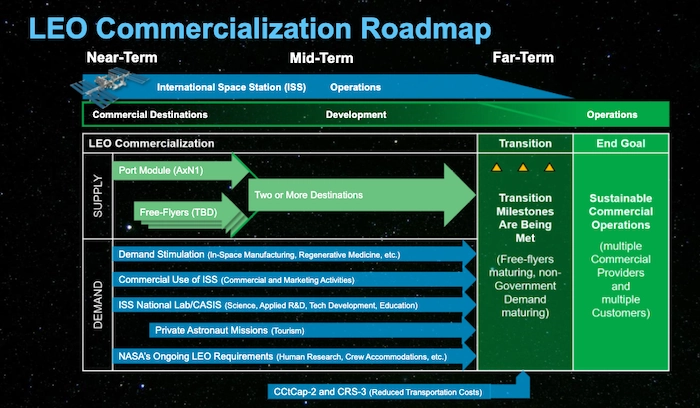I had the opportunity to attend the International Space Station National Lab (ISS) R&D Conference 2020. The main topic was the commercialization of the Low Earth Orbit, i.e. LEO. It is not coincidence that this comes together at the time the ISS reaches its 20th year of continuous human occupation.
The primary objective of the commercialization is for the USA to achieve a continuous presence in LEO. For this, the United States is committed to facilitate the growth of the commercial space sector. More specifically, the goal is to transition from LEO activities that rely heavily on NASA sponsorship, to a regime where NASA is one of many customers. NASA will always have a presence in the lower orbit, however it will continue focusing more and more in stretching the limits of the understanding of the secrets of the universe, search for life elsewhere and protect and improve life on earth and space. On its current plan, the next LEO platforms after ISS retires will not be government-owned and operated.
What are the potential benefits of the LEO economy? Until now, around 50 private entities have performed commercial R&D activities in the ISS National Lab. This has helped to identify real commercial benefits beyond the great R&D (science) performed:
- Manufacturing in Space: Micro-gravity provides manufacturing possibilities that are simply not available on earth. Made in Space has been successfully delivering manufacturing capabilities to customers, to deliver e.g. fiber optics with greater characteristics that those built on earth.
- Industrial Bioscience/Biomedical: Micro-gravity allows better/different manipulation of cells and bio elements. Lambda Vision together with infrastructure provider Space Tango have advanced in the creation of protein-based artificial retinas, that when produced in volume would allow people with certain retinal degenerations to recover vision.
- Private astronauts: Think of it as civilians who do not belong to a national space agency. Who would be a private astronaut? Anyone: a tourist, an actor, an employee of a private space company, name it! Axiom Space signed a contract with SpaceX to transport the first private astronauts to and from the ISS. In addition, Axiom Space has been awarded the first commercial module in the ISS (planned for 2024), which will grow to become the first commercial space station ever.
- Supporting NASA efforts: NASA will continue exploration of space for science both on earth and space. The Artemis mission to go back to the moon, its Gateway project, mission to mars, Hubble telescope, and a large etcetera of existing and upcoming mission will require support from the commercial sector.
When can LEO be a cost effective move to enterprises to invest on it? That's a key question. The US government thru the space council and NASA have established a roadmap.

LEO commercialization roadmap, from NASA.
- In the near-term, i.e. now, NASA established a commercial use and pricing policy for the ISS. It is dedicating 5% of its resources to commercial activities. It is also enabling flying of private astronauts to the ISS, it is working in developing private stations (private port being developed by Axiom Space), it has laid out a plan to stimulate demand thru a series of grants to the commercial sector. Plans for Free-Flyers (i.e. private companies and spacecrafts operating missions, not organized by NASA) which included the first solicitation have been delayed. NASA continue evaluating its possibilities.
- In the mid-term, NASA and its early commercial partners have identified one major area to tackle, seen as the main inhibitor in scaling the LEO economy: The reduction of the transportation costs. In addition to it, NASA plans to support the development of additional stations and continue identifying opportunities where LEO brings unique value.
- In the longer-term, NASA expects, once free-flyers and the non-government demand matures (i.e. once there is an establish supply-demand market), to start a transition into sustainable commercial operations.
What are the main challenges to achieve this vision? As you may imagine, there are many complexities, roadblocks and uncertainties while companies make the first steps in building this economy: Regulatory uncertainty (e.g. no regulation for in-orbit operations, allocation of risk for insurers), NASA investment forecast uncertainty (given it is currently the only volume customer out there), limited access to experiments in space (and long planning cycles), intellectual property ownership among other factors, are things that add to the inherent risk of any new endeavor, affecting the estimations to time-to-revenue and growth, which in short limits traditional venture capital availability as well as limit the amount of established companies that see LEO attractive. These are things the national administration is well aware of, and now working to provide incentives to continue activating this market. Initiatives such as additional NASA investment funding, a firm NASA forecast for commercial sector, space R&D tax credit, are just some of the initiatives being considered. In addition, private companies such as Virgin Galactic and Blue Origin are working to provide Sub-orbital flights, which although they don't provide a permanent settlement in LEO, it allows for experiencing micro-gravity environments for minutes, which will provide a much lower cost (money and time to prepare) option to companies to start the experimentation without the need of sending materials to the ISS.
The LEO economy is just about to start, and it is fascinating. For more information, visit NASA LEO economy website.
Header image: Axiom Earth Observatory Interior concept. Property of Axiom Space.
